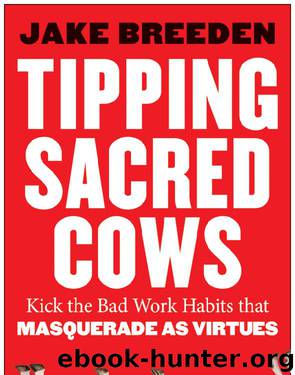Tipping Sacred Cows by Breeden Jake

Author:Breeden, Jake
Language: eng
Format: epub
Publisher: Wiley
Published: 2013-01-09T16:00:00+00:00
A Second-Rate Path to a First-Rate Destination
After Bubba Watson won his first PGA Tour event, the Traveler's Championship in Connecticut, he shared his start to the game of golf with a reporter from the Hartford Courant: “I never had a [formal golf] lesson. My dad, he took me to the course when I was 6, just told me he was going to be in the woods looking for his ball, so take this 9-iron and beat it down the fairway.”6 As Watson was winning the 2012 Masters, Sir Nick Faldo, a three-time winner of the tournament, described Watson's awkward, nontraditional swing. “It's not what you'd teach,” said Faldo, “but it works.” Faldo might question the excellence of Watson's swing, but he can't question the result.
Like Watson, Ed Catmull illustrates the desire for a relentlessly high standard in destination, but comfort in messiness along the way. Catmull cofounded Pixar and became the president of Disney Animation after Disney acquired Pixar. Many years before being acquired, Pixar signed a distribution deal with Disney that enabled them to get wide release for Toy Story, the smash hit that saved the company (before Disney signed the distribution deal that made Toy Story possible, Steve Jobs was in talks with Microsoft to sell Pixar to them). As part of the distribution deal, Disney asserted they had control over the sequel to Toy Story. Disney made sequels more cheaply and quickly than originals, and sent them straight to video, not to theaters. Under these terms, Pixar started down the path of making Toy Story 2 as a subpar sequel when Ed and other leaders at Pixar, including Toy Story director John Lasseter, slammed on the brakes.
In a Harvard Business Review article and podcast, Catmull describes Pixar's unyielding dedication to hold each of their films to the same standard of quality. He tells the story of stopping other productions to make time to bring Toy Story 2 up to their standards. Lasseter, in the documentary The Pixar Story, describes rewriting the film in one weekend. The new script demanded better special effects than the computer animators had ever created and it included a serious, slow ballad that explored the complex emotions of loss and abandonment. Toy Story 2 would not be the trite, slapped-together sequel that had become the industry standard. “By rejecting mediocrity at great pain and personal sacrifice,” Catmull said in the Harvard Business Review article, “we made a loud statement as a community that it was unacceptable to produce some good films and some mediocre films. As a result of Toy Story 2, it became deeply ingrained in our culture that everything we touch needs to be excellent.”7
Sounds like Colin Powell, right? Everything we touch needs to be excellent. But look closer at the Pixar creative process and you'll find a cultural norm of sharing unfinished scene sketches and regular check-ins to review very rough work that may never turn into anything usable. It's a daily habit for these animators to show incomplete work to one another.
Download
This site does not store any files on its server. We only index and link to content provided by other sites. Please contact the content providers to delete copyright contents if any and email us, we'll remove relevant links or contents immediately.
Hit Refresh by Satya Nadella(9083)
The Compound Effect by Darren Hardy(8870)
Change Your Questions, Change Your Life by Marilee Adams(7684)
Nudge - Improving Decisions about Health, Wealth, and Happiness by Thaler Sunstein(7656)
The Black Swan by Nassim Nicholas Taleb(7055)
Deep Work by Cal Newport(6966)
Rich Dad Poor Dad by Robert T. Kiyosaki(6511)
Daring Greatly by Brene Brown(6473)
Principles: Life and Work by Ray Dalio(6296)
Playing to Win_ How Strategy Really Works by A.G. Lafley & Roger L. Martin(6080)
Man-made Catastrophes and Risk Information Concealment by Dmitry Chernov & Didier Sornette(5956)
Digital Minimalism by Cal Newport;(5704)
Big Magic: Creative Living Beyond Fear by Elizabeth Gilbert(5676)
The Myth of the Strong Leader by Archie Brown(5456)
The Slight Edge by Jeff Olson(5376)
Discipline Equals Freedom by Jocko Willink(5336)
The Motivation Myth by Jeff Haden(5174)
The Laws of Human Nature by Robert Greene(5080)
Stone's Rules by Roger Stone(5051)
